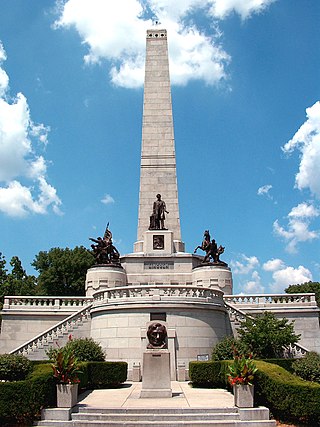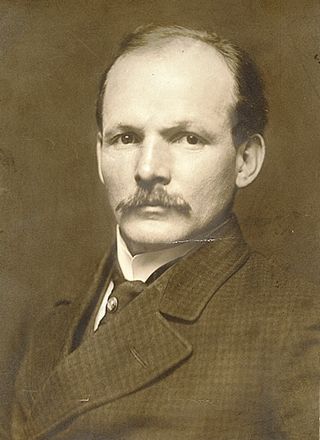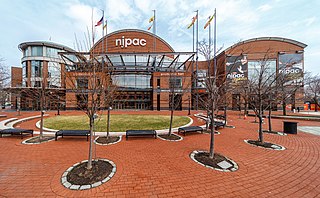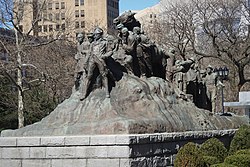
The Mount Rushmore National Memorial is a national memorial centered on a colossal sculpture carved into the granite face of Mount Rushmore in the Black Hills near Keystone, South Dakota, United States. Sculptor Gutzon Borglum designed the sculpture, called Shrine of Democracy, and oversaw the project's execution from 1927 to 1941 with the help of his son, Lincoln Borglum. The sculpture features the 60-foot-tall (18 m) heads of four United States presidents: George Washington, Thomas Jefferson, Theodore Roosevelt, and Abraham Lincoln, chosen to represent the nation's birth, growth, development, and preservation, respectively. Mount Rushmore attracts more than two million visitors annually to the memorial park which covers 1,278 acres. The mountain's elevation is 5,725 feet (1,745 m) above sea level.

John Gutzon de la Mothe Borglum was an American sculptor best known for his work on Mount Rushmore. He is also associated with various other public works of art across the U.S., including Stone Mountain in Georgia, statues of Union General Philip Sheridan in Washington D.C. and in Chicago, as well as a bust of Abraham Lincoln exhibited in the White House by Theodore Roosevelt and now held in the United States Capitol crypt in Washington, D.C.

The Lincoln Tomb is the final resting place of Abraham Lincoln, the 16th president of the United States; his wife Mary Todd Lincoln; and three of their four sons: Edward, William, and Thomas. It is located in Oak Ridge Cemetery in Springfield, Illinois.

Solon Hannibal de la Mothe Borglum was an American sculptor. He is most noted for his depiction of frontier life, and especially his experience with cowboys and native Americans.

The New Jersey Performing Arts Center (NJPAC), in Downtown Newark in Newark, New Jersey, is one of the largest performing arts centers in the United States. Home to the New Jersey Symphony Orchestra (NJSO), more than nine million visitors have visited the center since it opened in October 1997 on the site of the former Military Park Hotel.

Military Park is a 6-acre (24,000 m2) city park in Downtown Newark in Newark, New Jersey. Along with Lincoln Park and Washington Park, it makes up the three downtown parks in Newark that were laid out in the colonial era. It is a nearly triangular park located between Park Place, Rector Street and Broad Street.

The construction of Mount Rushmore National Memorial began on October 4, 1927, and took 14 years to complete. The sculptor of the memorial was Gutzon Borglum, the son of Danish immigrants. He chose the two most famous presidents, George Washington and Abraham Lincoln, and chose Thomas Jefferson because of the 1803 Louisiana Purchase. Theodore Roosevelt was suggested by Calvin Coolidge. Borglum's original design was intended to go down to their waists, but time constraints and funding only provided for their heads.

Indian and the Puritan is a 1916 marble and bronze monument by Gutzon Borglum, the sculptor of Mount Rushmore, opposite 5 Washington Street, the Newark Public Library, in Washington Park of Newark in Essex County, New Jersey. It was added to the National Register of Historic Places on October 28, 1994, as part of the Public Sculpture in Newark, New Jersey Multiple Property Submission.

The Essex County Courthouse is located at the Essex County Government Complex in Newark, New Jersey, United States. It was built in 1904 and was added to the National Register of Historic Places on June 26, 1975, for its significance in art and architecture.

Seated Lincoln is a 1911 sculpture by Gutzon Borglum, located next to the Essex County Courthouse in Newark, Essex County, New Jersey. It was added to the National Register of Historic Places on March 30, 1995, for its significance in art.

The Nathaniel Wheeler Memorial Fountain is located in Bridgeport, Connecticut at the intersection of Fairfield and Park avenues. The fountain was built in 1912–1913 and was added to the National Register of Historic Places on April 4, 1985. The fountain consists of four elements: a central bronze figure of a mermaid rising out of a polished granite pool and three individually ornamented polished granite watering troughs at the angles of the triangular parcel of land raised above the street. The mermaid holds aloft a lamp in her right hand, and a baby in her left. Its tail is wrapped around two dolphins, and the faces of four babies appear in relief around the rim of the pool. The three surrounding troughs are each adorned with individualized figures.

General Philip Sheridan is a bronze sculpture that honors Civil War general Philip Sheridan. The monument was sculpted by Gutzon Borglum, best known for his design of Mount Rushmore. Dedicated in 1908, dignitaries in attendance at the unveiling ceremony included President Theodore Roosevelt, members of the President's cabinet, high-ranking military officers and veterans from the Civil War and Spanish–American War. The equestrian statue is located in the center of Sheridan Circle in the Sheridan-Kalorama neighborhood of Washington, D.C. The bronze statue, surrounded by a plaza and park, is one of eighteen Civil War monuments in Washington, D.C., which were collectively listed on the National Register of Historic Places in 1978. The sculpture and surrounding park are owned and maintained by the National Park Service, a federal agency of the Interior Department.

A bronze sculpture of American pioneer, newspaper editor and historian Harvey W. Scott (1838–1910) by Gutzon Borglum, sometimes called Harvey Scott or Harvey W. Scott, was installed on Mount Tabor in Portland, Oregon, United States, until being toppled in October 2020.

Harriet Tubman Square is a city square in Downtown Newark, New Jersey.

First Landing Party of the Founders of Newark is a marble monument with bas-relief and inscription by sculptor Gutzon Borglum (1867–1941) near the New Jersey Performing Arts Center in Newark, New Jersey. It was dedicated in 1916. It was listed on the New Jersey Register of Historic Places in 1990 and the National Register of Historic Places in 1994 as part of the Public Sculpture in Newark, New Jersey Multiple Property Submission.

A colossal bust of Abraham Lincoln was made by Gutzon Borglum and completed in 1908. The original marble sculpture is installed in the United States Capitol crypt, in Washington, D.C. Reproductions cast in bronze are installed in several other locations, including the Lincoln Tomb in Springfield, Illinois.

George Washington is an outdoor equestrian statue by the Scottish-American sculptor J. Massey Rhind located in Washington Park in Newark, New Jersey. It depicts General George Washington saying farewell to the troops of the Continental Army on November 2, 1783, and was dedicated on the anniversary of that event in 1912.
Public Sculpture in Newark, New Jersey is a Multiple Property Submission of the National Register of Historic Places (NRHP) in Newark, New Jersey that was submitted in 1994. The submission consists of several public sculptures in the city created by American sculptor Gutzon Borglum during the early 1900s. The submission was accepted by the NRHP on October 28, 1994.
The Essex County Government Complex is located in Newark, the country seat of Essex County, New Jersey, U.S. at west of end of Market Street in Downtown. It is home to the Essex County Executive, the Board of County Commissioners, and the constitutional officers of the county: the County Clerk, the County Surrogate, and the County Sheriff as well as the County Register. The Essex County Prosecutor's Office and the 5th Vininage of New Jersey Superior Court is based at the government complex, across from which is the campus of Essex County College. The complex comprises various buildings built since 1904, when the historic courthouse was constructed, and is adorned with public art, including statues and busts of prominent civic leaders. Numerous state and county offices are located at the complex, which also has extensive parking facilities.




















